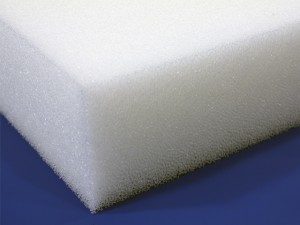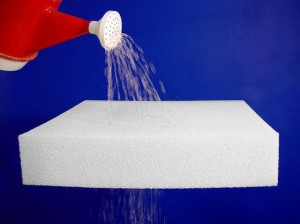
Foam is a versatile material with a variety of characteristics, ranging from cell type and strength to density, size, shape, and color. Certain types of foam enjoy widespread recognition, like the soft and squishy polyurethane foam or the robust closed-cell polyethylene foam. However, it’s crucial to acknowledge the unsung heroes—the foam varieties that quietly perform essential functions without seeking the limelight, like Dryfast foam. This versatile product is the best foam for outdoor cushions, and this post will explain why. Let’s get started!
What Is Dryfast Foam?
Dryfast foam stands out as a unique contender among the wide range of foam varieties. Classified as an open-cell foam, it boasts unparalleled porosity, distinguishing itself from its counterparts. Unlike traditional polyurethane sheet foam, where the cellular structure remains invisible from a distance, This foam’s almost-fibrous composition is visible even from afar. The cells in the foam are substantially larger, ranging from two to five millimeters, setting it apart from conventional open-cell foams.
Understanding the Reticulation Process
The production process behind Dryfast outdoor foam is as remarkable as the material itself. Employing either a chemical method known as quenching or a thermal process called zapping, the foam undergoes transformative treatments. In the quenching process, the foam passes through a caustic fluid, dissolving cell walls and leaving behind sturdy struts. Alternatively, the zapping method utilizes controlled flames within a vacuum-sealed environment to melt the cell walls, resulting in smoother struts.
Characteristics and Applications

Our Dryfast outdoor foams, manufactured via the zapping process, boast clean struts and a polished appearance. Beyond its manufacturing process, the foam offers versatility in applications. While it serves in roles such as air filtration and fuel line filters, it excels in comfort and support applications, particularly in outdoor settings. Its water-resistant and antimicrobial properties make it the ideal foam for outdoor cushions, marine upholstery, and other moisture-prone environments. Browse our complete selection of outdoor foam sheets & cushions for more information!
Unlike traditional foam materials prone to water retention and microbial growth, this foam allows water and air to pass through effortlessly. Its antimicrobial treatment further enhances durability and cleanliness, ensuring longevity even in challenging conditions. Cleaning the foam is a breeze, making maintenance hassle-free and preserving its pristine condition.
Elevating Your Foam Selection
Our exploration of Dryfast foam underscores the remarkable diversity within the foam industry. By studying the intricacies of foam composition, manufacturing processes, and applications, we gain a deeper appreciation for the resourcefulness and adaptability of materials like this foam. From its unparalleled porosity to its antimicrobial properties, the foam stands as a testament to innovation and excellence in foam engineering. Whether enhancing outdoor comfort with water-resistant cushions or safeguarding marine upholstery against moisture and microbial growth, Dryfast foam represents a versatile solution for diverse applications. Let Foam by Mail be your guide in exploring the vast potential of foam, elevating your projects with quality, durability, and performance unmatched in the industry!


We have a large sailboat cockpit and are looking at buying your Dry Fast foam, 4 inch thickness for the bottom cushions and 2 inch thickness for the back rests. Do you recommend putting a layer of closed cell for the strictly the bottom layer? If yes, 1. what thickness. 2. if we glue it on, do you recommend putting in holes for drainage? Is all of your foam medium or do you also have firm as well? We will be using Phifertex Plus material on these cushions. Thank you Lauri and Chuck, sv Free Spirit
You should be OK with just the dryfast foam.
how much faster does it dry than a typical outdoor foam cushion? Would love to replace the water hogs we have now…
The dryfast foam we carry will be mostly dry after a few minutes.
I want to replace & recover the cushions in my outdoor patio set (3 seat sofa and 2 lounge chairs). My cushions are comfortable and do not sink down too much when sitting. Will the dry fast foam be thick and firm enough to avoid that sinking, squishy feel of some cushions?
Yes, the dryfast foam should be a good replacement for your application.
I am a workroom that is recovering clients covered patio chairs but the insert need to be replaced. Need two 22x22x4″ pieces of foam. How much??? Shipping??? Thx
Please Contact Us for pricing and shipping costs.
Needing (6) 4 x 19 x19 Cushions price and shipping to LA
Please Contact Us for custom sizing and pricing.
I just purchased an outdoor seating set and the cushions are VERY firm to the point of being uncomfortable. Manufacturer is Sirio. I’m considering replacing the cushions but am afraid that these would be equally as firm as the ones I already have? Is this my only option for outdoor cushions? This would be for a screened porch and we plan to keep the cushions out of the rain.
Dryfast is the foam we typically recommend for outdoor use if the foam will be getting wet. If you want something less firm, and you do not plan on the foam getting wet, then you could go with our mildew-resistant HD36-HQ foam. This foam will retain water if it gets wet, but will resist mildew growth.
I need 6 – 3” x 19” x 19” pieces of foam for outdoor chair cushions. I’m located in Silver Spring, MD.
Please Contact Us for more information.
We’re looking for 6 pcs 22×22 of the dry fast for outdoor chair cushions in AZ.
Thx
These foam outdoor custom cushions can be purchase through our website on our Custom Cut Outdoor Cushion page. If you have any other questions, please feel free to Contact Us directly.
We use our patio chairs a lot and the seats cave in within months. Is your product going to do this?
The lifespan of any foam can vary greatly depending on the conditions it used in. That said, our Dryfast Foamhas a typical lifespan of 5-8 years.
Would Dryfast Foam be comfortable if used for outdoor back cushions?
Dryfastfoam may be a little firm for a back cushion if thicker than 2″ or 3″. If the cover is a weather resistant material, our Super Softfoam may be the best option. Please Contact Usfor further questions regarding your inquiry.
How long can I store this foam in a vacuum bag? I am making outdoor cushions for a retailer and they would like to store them in a small box to save warehouse space.
We typically do not recommend leaving them in a vacuum sealed bag for longer than 2 weeks. Any longer than this, and the foam can become permanently deformed. Please Contact Usif you have any other questions.
My husband sweats while working out in gym but dries off (not dripping) before sitting down. I’m using outdoor, water repellent fabric for window seat covers and pillows. Do I need to also use weather resistant foam?
Hello Jamie,
If your window seat cushions are indoors and you are already using a waterproof cover, you don’t need to use DryFast as your cushion core.
DryFast is an outdoor foam and is a firm type of material, as the cells are spread wider apart so if the cushions get wet or caught in the rain, the water drains right through them.
For Indoor cushions at 2”-3” we would suggest using the Lux-HQ Foam with a Dacron Fiberfill Wrap. This is a firm cushion wish some “bounce” to the feel, the Dacron will give your cushion a nice rounded finish to them. With foam only, once in a cover the cushion will have more of a flat box style look.